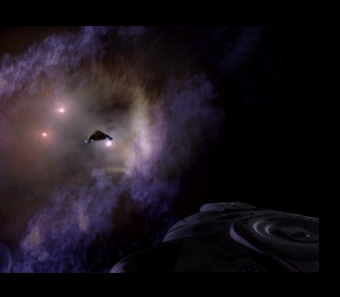|

In Star Trek, a subspace compression anomaly is a rare
subspace astronomical phenomenon, that miniaturizes objects that enter
its accretion disk. These anomalies emit high levels of gamma radiation.
In 2374, Starfleet ordered the USS Defiant to
investigate one such anomaly, in the hopes of collecting data that
could lead to the development of transwarp corridors. The runabout USS
Rubicon was lowered into the anomaly with a tractor beam, where it
shrank to a fraction of its normal size. The mission was interrupted by
a Jem'Hadar ambush. Contrary to predictions, the Rubicon did not return
to normal size when it left the anomaly. After helping to defeat the
Jem'Hadar in its miniaturized state, the runabout and its crew were
restored to normal size by re-entering the anomaly along its previous
course. (DS9: "One Little Ship").
There are certainly no known actual astrophysical
phenomena that can miniaturize objects intact. However, many
astrophysical phenomena do emit gamma radiation. Gamma-ray bursts
(GRBs) are the most luminous electromagnetic events occurring in the
universe since the Big Bang. They are flashes of gamma rays emanating
from seemingly random places in deep space at random times. The
duration of a gamma-ray burst is typically a few seconds, but can range
from a few milliseconds to several minutes, and the initial burst is
usually followed by a longer-lived "afterglow" emitting at longer
wavelengths (X-ray, ultraviolet, optical, infrared, and radio).
Gamma-ray bursts are detected by orbiting satellites about two to three
times per week.
Most observed GRBs appear to be collimated emissions
caused by the collapse of the core of a rapidly rotating, high-mass
star into a black hole. A subclass of GRBs (the "short" bursts) appear
to originate from a different process, the leading theory being the
collision of neutron stars orbiting in a binary system. All observed
GRBs have originated from outside our own galaxy; though a related
class of phenomena, SGR flares, are associated with galactic magnetars.
The sources of most GRBs have been billions of light years away.
|
|
